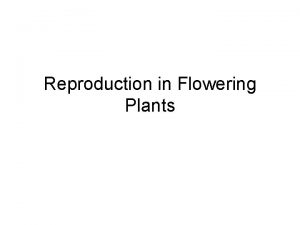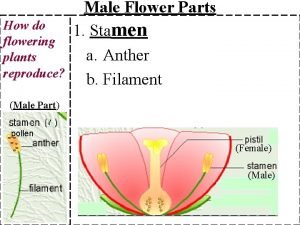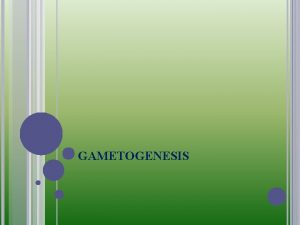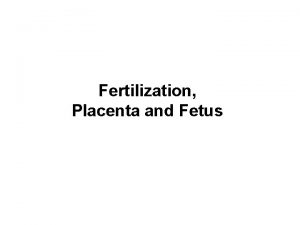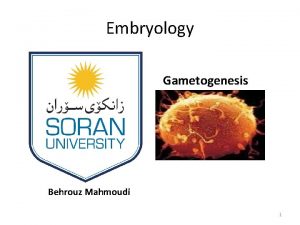Gametogenesis development of male and female gametes and







- Slides: 7

Gametogenesis - development of male and female gametes and their structures Female gamete formation: The formation of female gametes take place inside the ovules which consists of following steps: v. Mega sporogenesis v. Mega gametogenesis

Gametogenesis: The production of male and female gametes in the microspores and the megaspores, respectively, is known as gametogenesis. Microgametogenesis. This refers to the production of male gamete or sperm. During the maturation of pollen, the microspore nucleus divides mitotically to produce a generative and a vegetative or tube nucleus. The pollen is generally released in this binucleate stage. When the pollen lands onto the stigma of a flower, it is known as pollination. Shortly after pollination, the pollen germinates. The pollen tube enters the stigma and grows through the style.

The generative nucleus now undergoes a mitotic division to produce two male gametes or sperms. The pollen, along with the pollen tube, is known as microgametophyte. The pollen tube finally enters the ovule through a small pore, micropyle, and discharges the two sperms into the embryo sac. Megagametogenesis: The nucleus of a functional megaspore divides mitotically to produce four or more nuclei. The exact number of nuclei and their arrangement vary considerably from one species to another. In most of the crop plants, megaspore nucleus undergoes three mitotic divisions to produce eight nuclei.

Three of these nuclei move to one pole and produce a central egg cell and two synergid cells; one synergid is situated on either side of the egg cell. Another three nuclei migrate to the opposite pole to give rise to antipodal cells. The two nuclei remaining in the centre, the polar nuclei, fuse to form a secondary nucleus. The megaspore thus develops into a mature megagametophyte or embryo sac. The development of embryo sac from a megaspore is known as megagametogenesis. The embryo sac generally contains one egg cell, two synergids, three antipodal cells (all haploid), and one diploid secondary nucleus.

• Megaspore mother cell undergoes meiosis to yield four haploid megaspores. • Only one of the four megaspores function and form the female gametophyte, the remaining upper three megaspores degenerate. • Normally, the chalazal megaspore of tetrad is functional. • The megasporangium together with the integuments, is called ovule. • It is affixed to the placenta, on the inner wall of the ovary, by a stalk called funiculus. • An ovule ready for fertilization constitutes of nucellar tissue covered almost completely by one or two integuments, leaving a small opening at the apical end. • This opening termed as micropyle is the main passage for the entry of the pollen tube in the ovule. • The basal region of the ovule where funiculus is affixed is called chalaza. • In the nucellus, the female gametophyte is present, also called embryo sac.






